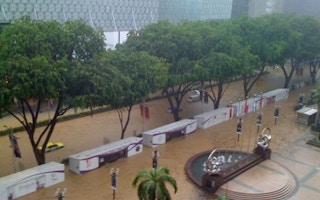Singapore will most likely be receiving higher-than-average rainfall due to climate change and it will need to address the higher risks of floods that come with it, said experts at a seminar last week.
Some solutions to urban flooding that Singapore can consider include upgrading infrastructure with new features such as the conversion of a car park into a rain garden, which has been tried and tested in the United States, said Professor David Balmforth, vice president of the Institution of Civil Engineers, at a seminar last Tuesday at the National University of Singapore (NUS).
Professor Balmforth, also an executive technical director of global water engineering firm MWH consultants, is one of the experts appointed by the Singapore Government. The panel will advise the Ministry of Environment and Water Resources on how to adopt new urban planning measures – such as improved drainage design – to reduce the potential increase in urban flooding from climate change.
The panel was set up after Singapore experienced a series of flash floods in the past year, which caused much public discontent. The floods were attributed to higher-than-average rainfall in a relatively short period of time.
Although flood prone areas have decreased over the last two decades, flash floods, urban flooding and extreme events remain issues of concern to the government, which has called for an in-depth review of the flood protection measures to be implemented in Singapore over the next decade.
Speaking to a 85-strong audience of government officials, academics, business professionals and media, Professor Balmforth shared the findings of a major United Kingdom study by the government on climate change, flooding and coastal defence.
According to the study, of which Professor Balmforth is a principal contributor, over two million households are at risk from flooding in the UK alone, and flood management costs taxpayers over 800 million pounds each year.
During the summer of 2007, the wettest on record, the UK received heavy rainfall that caused major urban flooding. Key infrastructures were affected, and the main motorway that connects London to the North of England was closed for three days. “It was the first time the M1 motorway had ever been closed for more than 24 hours,” noted Professor Balmforth.
The UK study concluded that the average rainfall in the UK could increase up to 40 per cent. The continuing rise of the costs of managing the extra rainfall makes current conventional solutions economically unsustainable, said Professor Balmforth.
He added that new approaches are needed, and finding these will require sharing data and knowledge from different regions and from various professions as well.
The economic benefits of retrofitting local drainage systems are considerable, said Professor Balmforth. He provided several examples, including a programme in the Netherlands, where members of the public helped with the detailed design needed to improve their community infrastructure to manage heavier rainfall, and an initiative in the City of Portland, Oregon that uses annual incentives to encourage home owners to connect their rainwater gutter to their gardens.
For every dollar spent on small localised projects like these, the government can avoid spending two and a half dollars on larger, more expensive projects such increasing water pathways and their capacity levels, or building bigger localised storage infrastructure, he noted.
Climate change will have a large impact on urban flooding and the effects will certainly be felt in areas that already receive heavy rainfall, such as Southeast Asia, said Professor Balmforth.
He added that the real challenge will be to find solutions in the developing world, where slum communities are often located in flood risk areas.
“One size does not fit all,” said Professor Balmforth on the sidelines of the seminar. He said that experts have to look at the solutions that can address the specific needs of each community.
He cited a number of extreme weather events resulting in severe floods that have hit Southeast Asia recently, such as the monsoon rains, floods and mudslides that have deluged Thailand, and the arrival last week of deadly Typhoon Nesat in the Philippines.
Such extreme events will continue to happen, but communities “need to know where the flood water will go when it can’t get into the system,” said Professor Balmforth.
The British High Commission in Singapore’s first secretary for science and innovation, Matthew Crossman, told Eco-Business that with the changing climate, collaborative efforts are necessary to find the right solutions to urban flooding.
The UK-Singapore Partners in Science, a British High Commission initiative set up in 2005 to foster collaboration between scientists in the UK and Singapore, organised the evening seminar to promote just such collaborative efforts.
First secretary Crossman also said that Southeast Asia is a region that is clearly affected by climate change. “The solutions are here, but nobody can act alone.”

















